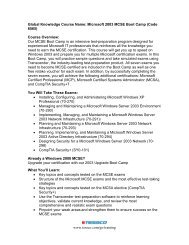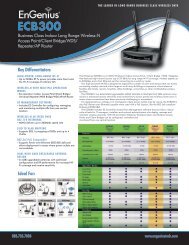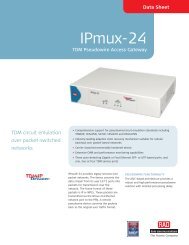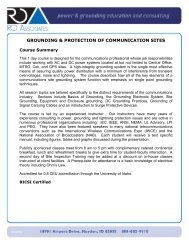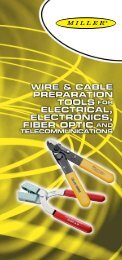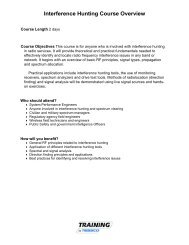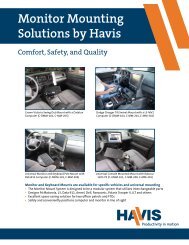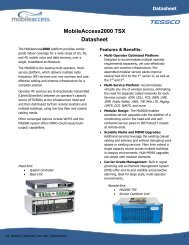Agilent FieldFox RF Analyzer N9912A - Tessco
Agilent FieldFox RF Analyzer N9912A - Tessco
Agilent FieldFox RF Analyzer N9912A - Tessco
Create successful ePaper yourself
Turn your PDF publications into a flip-book with our unique Google optimized e-Paper software.
<strong>Agilent</strong><br />
<strong>FieldFox</strong><br />
<strong>RF</strong> <strong>Analyzer</strong><br />
<strong>N9912A</strong><br />
Data Sheet
Documentation Warranty<br />
THE MATERIAL CONTAINED IN THIS DOCUMENT IS PROVIDED "AS IS," AND IS SUBJECT TO<br />
BEING CHANGED, WITHOUT NOTICE, IN FUTURE EDITIONS. FURTHER, TO THE MAXIMUM<br />
EXTENT PERMITTED BY APPLICABLE LAW, AGILENT DISCLAIMS ALL WARRANTIES,<br />
EITHER EXPRESS OR IMPLIED WITH REGARD TO THIS MANUAL AND ANY INFORMATION<br />
CONTAINED HEREIN, INCLUDING BUT NOT LIMITED TO THE IMPLIED WARRANTIES OF<br />
MERCHANTABILITY AND FITNESS FOR A PARTICULAR PURPOSE. AGILENT SHALL NOT BE<br />
LIABLE FOR ERRORS OR FOR INCIDENTAL OR CONSEQUENTIAL DAMAGES IN<br />
CONNECTION WITH THE FURNISHING, USE, OR PE<strong>RF</strong>ORMANCE OF THIS DOCUMENT OR<br />
ANY INFORMATION CONTAINED HEREIN. SHOULD AGILENT AND THE USER HAVE A<br />
SEPARATE WRITTEN AGREEMENT WITH WARRANTY TERMS COVERING THE MATERIAL IN<br />
THIS DOCUMENT THAT CONFLICT WITH THESE TERMS, THE WARRANTY TERMS IN THE<br />
SEPARATE AGREEMENT WILL CONTROL.<br />
DFARS/Restricted Rights Notice<br />
If software is for use in the performance of a U.S. Government prime contract or subcontract, Software is<br />
delivered and licensed as “Commercial computer software” as defined in DFAR 252.227-7014 (June 1995),<br />
or as a “commercial item” as defined in FAR 2.101(a) or as “Restricted computer software” as defined in<br />
FAR 52.227-19 (June 1987) or any equivalent agency regulation or contract clause. Use, duplication or<br />
disclosure of Software is subject to <strong>Agilent</strong> Technologies’ standard commercial license terms, and non-<br />
DOD Departments and Agencies of the U.S. Government will receive no greater than Restricted Rights as<br />
defined in FAR 52.227-19(c)(1-2) (June 1987). U.S. Government users will receive no greater than Limited<br />
Rights as defined in FAR 52.227-14 (June 1987) or DFAR 252.227-7015 (b)(2) (November 1995), as<br />
applicable in any technical data.<br />
2
Table of Contents<br />
Definitions<br />
Specification (spec.)<br />
Cable and Antenna <strong>Analyzer</strong> ........................................................... 4<br />
Network <strong>Analyzer</strong> (Option 303) ...................................................... 8<br />
Spectrum <strong>Analyzer</strong> (Option 230 and 231) ................................... 13<br />
Preamplifier (Option 235) ............................................................... 21<br />
Interference <strong>Analyzer</strong> (Option 236) .............................................. 21<br />
Power Meter (Option 302) ............................................................. 21<br />
General Information ........................................................................ 21<br />
Supported Cal Kits .......................................................................... 25<br />
Warranted performance. Specifications include guardbands to account for the expected statistical performance<br />
distribution, measurement uncertainties, and changes in performance due to environmental conditions. The following<br />
conditions must be met:<br />
• <strong>FieldFox</strong> has been turned on at least 90 minutes<br />
• <strong>FieldFox</strong> is within its calibration cycle<br />
• Storage or operation at 25°C ±5 °C range (unless otherwise stated)<br />
Typical (typ.)<br />
Expected performance of an average unit over a 20 °C to 30 °C temperature range after being at ambient temperature<br />
for two hours, unless otherwise indicated; does not include guardbands. It is not covered by the product warranty. The<br />
<strong>FieldFox</strong> must be within its calibration cycle.<br />
Nominal (nom.)<br />
A general, descriptive term or design parameter. It is not tested, and not covered by the product warranty.<br />
Calibration<br />
The process of measuring known standards to characterize an instrument's systematic (repeatable) errors.<br />
Corrected (residual)<br />
Indicates performance after error correction (calibration). It is determined by the quality of calibration standards and<br />
how well "known" they are, plus system repeatability, stability, and noise.<br />
Uncorrected (raw)<br />
Indicates instrument performance without error correction. The uncorrected performance affects the stability of a<br />
calibration.<br />
3
Cable and Antenna <strong>Analyzer</strong><br />
Description Specification Typical Supplemental Information<br />
10 minute<br />
warm up<br />
90 minute<br />
warm up<br />
Frequency Range<br />
Option 104<br />
Option 106<br />
2 MHz to 4 GHz<br />
2 MHz to 6 GHz<br />
Frequency Reference<br />
Accuracy ±2 ppm ±2 ppm<br />
Aging Rate ±1 ppm/yr ±1 ppm/yr<br />
Temperature Stability ±1 ppm over 0 to 55 ºC ±1 ppm<br />
Frequency Resolution<br />
2 MHz to 1.6 GHz 2.5 kHz<br />
> 1.6 GHz to 3.2 GHz 5 kHz<br />
> 3.2 GHz to 6 GHz 10 kHz<br />
Resolution (Number of data points)<br />
101, 201, 401, 601, 801,<br />
1001<br />
Measurement Speed<br />
Return Loss<br />
DTF<br />
1.75 GHz – 3.85 GHz,<br />
1001 points, Cal ON<br />
0 to 500 ft, 601<br />
points, Cal ON<br />
1.5 ms/point (nominal)<br />
2.4 ms/point (nominal)<br />
Output Power (<strong>RF</strong> Out Port)<br />
High<br />
2 MHz to 4 GHz < +8 dBm, +6 dBm (nominal)<br />
> 4 GHz to 6 GHz < +7 dBm, +2 dBm (nominal)<br />
Low (Typically 31 dB below high power)<br />
2 MHz to 4 GHz < –23 dBm, –25 dBm (nominal)<br />
> 4 GHz to 6 GHz < –24 dBm, –25 dBm (nominal)<br />
Immunity to Interfering Signals<br />
+16 dBm (nominal)<br />
4
Maximum Measurable Cable Loss Using 1–Port CAT Measurement Model 2 Refl Dyn Range /2<br />
Cable and Antenna <strong>Analyzer</strong> (continued)<br />
Description Specification Typical<br />
10 minute warm up 90 minute warm up<br />
Directivity<br />
Corrected with OSL calibration 1 >42 dB >42 dB<br />
Corrected with QuickCal (Option 111) 3<br />
≥42 dB<br />
Raw<br />
2 MHz to 3.5 GHz > 20 dB<br />
> 3.5 GHz to 6 GHz > 14 dB<br />
Source Match<br />
Corrected with OSL calibration 1 > 36 dB > 36 dB<br />
Corrected with QuickCal (Option 111) 3<br />
≥35 dB<br />
Raw<br />
2 MHz to 3 GHz > 25 dB<br />
> 3 GHz to 6 GHz > 16 dB<br />
Reflection Tracking<br />
Corrected with OSL calibration 1 ±0.06 dB ±0.06 dB<br />
Corrected with QuickCal (Option 111) 3<br />
±0.15 dB<br />
Reflection Dynamic Range<br />
Reflection (<strong>RF</strong> Out port) (High power out)<br />
2 MHz to 4 GHz 60 dB<br />
> 4 GHz to 6 GHz 55 dB<br />
Transmission Dynamic Range(Option 110)<br />
300 Hz IF Bandwidth<br />
2 MHz to 2 GHz 72 dB<br />
> 2 GHz to 3 GHz 67 dB<br />
> 3 GHz to 5 GHz 58 dB<br />
> 5 GHz to 6 GHz 49 dB<br />
Return Loss<br />
Display Range<br />
Resolution<br />
0 to 100 dB<br />
0.01 dB<br />
VSWR<br />
Display Range 1 to 500<br />
Resolution 0.01<br />
Cable Loss<br />
Display Range<br />
Resolution<br />
0 to 100 dB<br />
0.01 dB<br />
5
Cable and Antenna <strong>Analyzer</strong> (continued)<br />
Description Specification Supplemental Information<br />
Distance–to–Fault<br />
Horizontal Range Range = [(number of points – 1) /<br />
frequency span * 2] * velocity factor *<br />
speed of light<br />
Horizontal<br />
Resolution<br />
Bandpass Mode<br />
Window Types<br />
1 Using recommended calibration kits.<br />
Resolution = Range / (number of<br />
points – 1)<br />
Number of points auto coupled according to start<br />
and stop distance entered<br />
Number of points settable by user<br />
Maximum, medium, and minimum windows<br />
2 Higher cable losses can be measured using transmission or S21 measurements. Cable losses measured in<br />
transmission mode limited by transmission dynamic range.<br />
3 QuickCal is performed with the connect LOAD step.<br />
Figure 1: CAT Mode, Type–N Calibration Kit – Magnitude (Specification)<br />
6
Cable and Antenna <strong>Analyzer</strong> (continued)<br />
Figure 2: CAT Mode, QuickCal – Magnitude (Typical)<br />
Figure 3: CAT Mode, Preset Cal – Magnitude (Typical)<br />
7
Network <strong>Analyzer</strong> (Option 303)<br />
The following CAT mode performance parameters apply to NA mode: frequency accuracy, frequency resolution, output<br />
power, directivity, source match, reflection tracking, and reflection and transmission dynamic range. NA mode<br />
performance that is in addition to CAT mode is listed in the table below.<br />
Description Specification Supplemental Information<br />
Frequency Range<br />
Measurement Speed<br />
S11: 1.75 GHz – 3.85 GHz,<br />
1001 Points, Cal ON<br />
S21: 1.78 GHz – 2.06 GHz,<br />
201 Points, Cal ON<br />
2 MHz to 4 GHz Option 104<br />
2 MHz to 6 GHz Option 106<br />
1.5 ms/point (nominal)<br />
1.9 ms/point (nominal)<br />
S11 Phase Uncertainty 1<br />
See Figure 5 on<br />
following page<br />
Display Range –180º to +180º<br />
System Impedance<br />
50Ω (nominal)<br />
75Ω with appropriate adapter and Cal Kit<br />
1 Using recommended calibration kits.<br />
Description<br />
Measurements<br />
Formats<br />
Resolution<br />
(Number of data points)<br />
Information<br />
Averaging 2 to 999<br />
Number of traces<br />
Data markers<br />
Marker formats<br />
Marker functions<br />
Display formats<br />
S11 magnitude and phase<br />
S21 magnitude (option 110)<br />
A receiver magnitude<br />
R receiver magnitude<br />
Log magnitude, Linear magnitude<br />
Available ONLY for S11:<br />
VSWR, Phase, Smith Chart, Polar, Group delay, Unwrapped phase<br />
101, 201, 401, 601, 801, 1601, 4001, 10001<br />
Custom number of points can be set using SCPI<br />
Averages vector data on each successive sweep<br />
Four traces available. Tr1, Tr2, Tr3, Tr4<br />
Each trace has six independent markers that can be displayed simultaneously. Delta<br />
markers are available for each marker.<br />
Default marker format is the trace format. In Smith chart or polar format,<br />
[Real +Imag] or [Mag and Phase] formats are also available.<br />
Peak, Next Peak, Peak Left, Peak Right, Mkr→ Center, Min Search, Peak Excursion,<br />
Peak Threshold, Target, Bandwidth, Tracking<br />
Single-trace<br />
Dual-trace overlay (both traces on one graticule)<br />
Dual-trace split (each trace on separate graticules)<br />
8
Display data<br />
Trace math<br />
Scale<br />
Title<br />
Limit lines<br />
Three-trace split (each trace on separate graticules)<br />
Quad-trace split (each trace on separate graticules)<br />
Display data, memory, data and memory, or data math<br />
Vector division or subtraction of current linear measurement values and memory data.<br />
Autoscale, scale, reference level, reference position<br />
Autoscale: Automatically selects scale resolution and reference value to center the<br />
trace. Autoscale all scales all visible traces.<br />
Add custom titles to the display.<br />
Define test limit lines that appear on the display for go/no go testing. Lines may be any<br />
combination of horizontal, sloping lines, or discrete data points. Each trace can have its<br />
own limit line.<br />
9
Network <strong>Analyzer</strong> (continued)<br />
Figure 4: NA Mode, Type–N Calibration Kit – Magnitude (Specification)<br />
Figure 5: NA Mode, Type–N Calibration Kit – Phase (Specification)<br />
10
Network <strong>Analyzer</strong> (continued)<br />
Figure 6: NA Mode, QuickCal – Magnitude (Typical)<br />
11
Network <strong>Analyzer</strong> (continued)<br />
Figure 7: NA Mode, Preset Cal – Magnitude (Typical)<br />
Figure 8: NA Mode, Preset Cal – Phase (Typical)<br />
12
Spectrum <strong>Analyzer</strong> (Option 230 and 231)<br />
Description Specification Supplemental Information<br />
FREQUENCY<br />
Frequency Range<br />
Option 230 100 kHz to 4 GHz Usable to 5 kHz 1<br />
Option 231 100 kHz to 6 GHz Usable to 5 kHz 1<br />
Tunable to 6.1 GHz<br />
Frequency Reference<br />
Accuracy<br />
±2 ppm<br />
Aging Rate<br />
± 1 ppm/yr<br />
Temperature Stability ± 1 ppm over –10 to 55 °C<br />
Frequency Readout Accuracy (start, stop, center, marker)<br />
± (readout frequency x frequency<br />
reference accuracy + RBW centering +<br />
0.5 x horizontal resolution)<br />
Horizontal resolution = span/(trace<br />
points – 1)<br />
RBW centering :<br />
5% x RBW, FFT mode (nominal)<br />
16% x RBW, Step mode (nominal)<br />
Frequency Span<br />
Range<br />
Accuracy<br />
Resolution<br />
Sweep Time, Span = 0 Hz<br />
Range<br />
Minimum<br />
Maximum<br />
RBW = 2 MHz<br />
RBW = 1 MHz<br />
RBW = 300 kHz<br />
RBW = 100 kHz<br />
RBW = 30 kHz<br />
RBW = 10 kHz<br />
RBW = 3 kHz<br />
RBW = 1 kHz<br />
RBW = 300 Hz<br />
Resolution<br />
Readout<br />
1 With signal at center frequency.<br />
0 Hz (zero span), 10 Hz to max freq<br />
±(2 x RBW centering + horizontal<br />
resolution)<br />
1 Hz<br />
1.0 us<br />
2.18 ms<br />
3.28 ms<br />
5.46 ms<br />
16.38 ms<br />
54.60 ms<br />
163.84 ms<br />
546.00 ms<br />
1.64 s<br />
2.54 s<br />
100.0 ns<br />
Entered value representing trace<br />
horizontal scale range.<br />
±(2 x RBW centering +2 x horizontal<br />
resolution) for detector = Normal<br />
13
Spectrum <strong>Analyzer</strong> (continued)<br />
Description Specification Supplemental Information<br />
Sweep Acquisition, Span > 0 Hz<br />
Range<br />
1 to 5000. Number of data acquisitions per<br />
trace point. Value is normalized to the<br />
minimum required to achieve amplitude<br />
accuracy with CW signals.<br />
Auto coupled. For pulsed <strong>RF</strong> signals,<br />
manually increase the sweep<br />
acquisition value to maximize the<br />
pulse spectrum envelope.<br />
Resolution 1<br />
Readout<br />
Measured value representing time required<br />
to tune receiver, acquire data, and process<br />
trace.<br />
Trigger<br />
Trigger Type<br />
Trigger Slope<br />
Trigger Delay<br />
Range<br />
Resolution<br />
Auto Trigger<br />
Auto Trigger Range<br />
Free Run, Video, External<br />
Positive, Negative edge<br />
0 to 10 sec<br />
100 nsec<br />
Forces a periodic acquisition in the absence<br />
of a trigger event<br />
0 sec (OFF) to 10 sec<br />
Time Gating<br />
Gate Method<br />
Gate Delay Range<br />
Triggered FFT<br />
Same as Trigger Delay<br />
Trace Update<br />
Span = 20 MHz, RBW = 3<br />
kHz<br />
Span = 100 MHz, RBW auto<br />
coupled<br />
Span = 6 GHz, RBW auto<br />
coupled<br />
1.5 updates/s (nominal)<br />
7 updates/s (nominal)<br />
1 update/s (nominal)<br />
Trace Points<br />
101, 201, 401, 601, 801, 1001<br />
(Defaults to 401)<br />
14
Spectrum <strong>Analyzer</strong> (continued)<br />
Description Specification Supplemental Information<br />
Resolution Bandwidth (RBW)<br />
Range (–3 dB bandwidth)<br />
Zero Span<br />
300 Hz to 1 MHz in 1–3–10 sequence; 2 MHz<br />
Non–Zero Span 10 Hz to 300 kHz in 1/1.5/2/3/5/7.5/10<br />
sequence; 1 MHz, 2 MHz<br />
Accuracy<br />
Step keys change RBW in<br />
1–3–10 sequence<br />
1 kHz to 1 MHz ± 5% (nominal)<br />
10 Hz to 100 kHz non–<br />
zero span<br />
± 1% (nominal)<br />
2 MHz ± 10% (nominal)<br />
300 Hz zero span ± 10% (nominal)<br />
Selectivity (–60 dB/ –3 dB)<br />
4:1 (nominal)<br />
Video Bandwidth (VBW)<br />
Range 1 Hz to 2 MHz in 1/1.5/2/3/5/7/10<br />
sequence<br />
VBW ≥ RBW in zero span<br />
Description Specification Typical<br />
Stability<br />
Noise Sidebands, CF = 1 GHz<br />
10 minute warm<br />
up<br />
90 minute warm<br />
up<br />
10 kHz offset < –85 dBc/Hz –88 dBc/Hz –88 dBc/Hz<br />
30 kHz offset –89 dBc/Hz –89 dBc/Hz<br />
100 kHz offset –95 dBc/Hz –95 dBc/Hz<br />
1 MHz offset –115 dBc/Hz –115 dBc/Hz<br />
Measurement Range<br />
Input Attenuator Range<br />
Resolution<br />
Displayed average noise level (DANL) to<br />
+20 dBm<br />
0 to 31 dB<br />
1 dB steps<br />
Maximum Safe Input Level<br />
Average Continuous Power +27 dBm (0.5 W)<br />
DC<br />
±50 VDC<br />
15
Spectrum <strong>Analyzer</strong> (continued)<br />
Description Specification Typical<br />
Displayed Average Noise Level (DANL)<br />
10 minute warm<br />
up<br />
10 Hz RBW, 10 Hz VBW, 50 ohm termination on input, 0 dB attenuation, average detector<br />
Preamplifier OFF<br />
20 to 30 °C:<br />
90 minute warm<br />
up<br />
10 MHz to 2.4 GHz –130 dBm<br />
> 2.4 GHz to 5.0 GHz –125 dBm<br />
> 5.0 GHz to 6.0 GHz –119 dBm<br />
Preamplifier ON (Option 235)<br />
20 to 30 °C:<br />
10 MHz to 2.4 GHz < –143 dBm –148 dBm<br />
> 2.4 GHz to 5.0 GHz < –140 dBm –145 dBm<br />
> 5.0 GHz to 6.0 GHz < –132 dBm –138 dBm<br />
–10 to 55 °C:<br />
Display Range<br />
10 MHz to 2.4 GHz < –141 dBm<br />
> 2.4 GHz to 5.0 GHz < –138 dBm<br />
> 5.0 GHz to 6.0 GHz < –130 dBm<br />
Log Scale Ten divisions displayed; 0.1 to 1.0<br />
dB/division in 0.1 dB steps, and 1 to 20<br />
dB/division in 1 dB steps<br />
Trace Detectors<br />
Trace States<br />
Number of Traces<br />
Number of Averages<br />
Reference Level<br />
Range<br />
Resolution<br />
Accuracy<br />
Normal, Positive Peak, Negative Peak,<br />
Sample, Average<br />
Clear/Write, Max Hold, Min Hold,<br />
Average, View, Blank<br />
4<br />
1 to 10,000<br />
–170 dBm to +30 dBm<br />
0.1 dB<br />
0 dB<br />
16
Spectrum <strong>Analyzer</strong> (continued)<br />
Description Specification Typical<br />
Absolute Amplitude Accuracy at 50 MHz<br />
10 minute warm<br />
up<br />
90 minute warm<br />
up<br />
Peak detector, 10 dB attenuation, preamplifier off, RBW < 2 MHz, input signal –5 dBm to –50 dBm, all settings auto–<br />
coupled<br />
20 to 30 ºC ±0.8 dB ±0.8 dB ±0.4 dB<br />
–10 to 55 ºC ±1.1 dB ±0.8 dB<br />
Frequency Response<br />
Relative to 50 MHz, Peak detector, 10 dB attenuation, preamplifier off, RBW = 30 kHz, input signal 0 dBm to –50 dBm,<br />
all settings auto–coupled<br />
20 to 30 ºC:<br />
2 MHz to 10 MHz ±1.1 dB ±1.0 dB ±0.5 dB<br />
> 10 MHz to 3.0 GHz ±0.9 dB ±0.6 dB ±0.3 dB<br />
> 3.0 GHz to 5.0 GHz ±1.3 dB ±1.1 dB ±0.5 dB<br />
> 5.0 GHz to 6.0 GHz ±1.5 dB ±1.5 dB ±0.5 dB<br />
–10 to 55 ºC:<br />
2 MHz to 10 MHz ±2.0 dB ±1.0 dB<br />
> 10 MHz to 3.0 GHz ±1.5 dB ±0.6 dB<br />
> 3.0 GHz to 5.0 GHz ±2.0 dB ±1.1 dB<br />
> 5.0 GHz to 6.0 GHz ±2.6 dB ±1.5 dB<br />
Preamplifier ON (Option 235)<br />
20 to 30 ºC:<br />
2 MHz to 10 MHz ±0.7 dB<br />
> 10 MHz to 3.0 GHz ±0.5 dB<br />
> 3.0 GHz to 5.0 GHz ±0.7 dB<br />
> 5.0 GHz to 6.0 GHz ±0.7 dB<br />
–10 to 55 ºC:<br />
2 MHz to 10 MHz ±1.2 dB<br />
> 10 MHz to 3.0 GHz ±0.8 dB<br />
> 3.0 GHz to 5.0 GHz ±1.3 dB<br />
> 5.0 GHz to 6.0 GHz ±1.7 dB<br />
17
Spectrum <strong>Analyzer</strong> (continued)<br />
Description Specification Typical Supplemental Information<br />
10 minute<br />
warm up<br />
90 minute<br />
warm up<br />
Resolution Bandwidth Switching Uncertainty<br />
RBW < 2 MHz<br />
0.0 dB<br />
0.7 dB peak–to–peak 3<br />
Total Absolute Amplitude Accuracy 1<br />
Peak detector, 10 dB<br />
attenuation, preamplifier off,<br />
RBW < 2 MHz, input signal 0<br />
dBm to –50 dBm, all settings<br />
auto coupled<br />
20 to 30 ºC:<br />
Absolute<br />
Amplitude at 50<br />
MHz + Frequency<br />
Response 4<br />
2 MHz to 10 MHz ±1.8 dB ±1.28 dB ±0.60 dB<br />
> 10 MHz to 3.0 GHz ±1.5 dB ±1.0 dB ±0.50 dB<br />
> 3.0 GHz to 5.0 GHz ±1.9 dB ±1.36 dB ±0.60 dB<br />
> 5.0 GHz to 6.0 GHz ±2.1 dB ±1.7 dB ±0.60 dB<br />
<strong>RF</strong> Input VSWR<br />
At all attenuation settings<br />
1.5:1 (nominal)<br />
Second harmonic distortion (SHI)<br />
–30 dBm signal at input<br />
mixer 2<br />
2 MHz to 1.35 GHz < –70 dBc<br />
+40 dBm SHI (nominal)<br />
1.35 GHz to 3.0 GHz < –80 dBc<br />
+50 dBm SHI (nominal)<br />
Third Order Intermodulation Distortion (TOI)<br />
Two –30 dBm tones at input<br />
mixer<br />
< –96 dBc<br />
+18 dBm TOI (nominal)<br />
1 With signal at center frequency.<br />
2 Mixer level = <strong>RF</strong> input level – input attenuation<br />
3 For signals not at center frequency.<br />
4 The specification for Total Absolute Amplitude Accuracy is less than the sum of the Absolute Amplitude Accuracy<br />
and Frequency Response specifications because redundant uncertainty is removed.<br />
18
Spectrum <strong>Analyzer</strong> (continued)<br />
Description<br />
Supplemental Information<br />
Residual Responses<br />
Input terminated, 0 dB attenuation, preamplifier off, RBW ≤ 1 kHz, VBW auto coupled<br />
20 MHz to 3 GHz –90 dBm (nominal)<br />
> 3 GHz to 6 GHz –85 dBm (nominal)<br />
Spurious Responses<br />
Input Mixer level –30 dBm<br />
<strong>RF</strong>sig = <strong>RF</strong>tune + 417 MHz<br />
<strong>RF</strong>sig = <strong>RF</strong>tune + 1.716 GHz<br />
Input Mixer level –10 dBm; First IF Image Response<br />
Rfsig = Rftune – 2 x 0.8346 GHz<br />
for Rftune 5.7 to 6.0 GHz<br />
Sidebands<br />
–70 dBc (nominal)<br />
–80 dBc (nominal)<br />
–50 dBc (nominal)<br />
–80 dBc (nominal)<br />
–60 dBc (nominal) when battery<br />
charging, 260 kHz offset<br />
Figure 10<br />
19
Figure 11<br />
Description<br />
Specification<br />
Independent Signal Source or Tracking Generator<br />
The independent source or tracking generator is included with either spectrum<br />
analyzer option. The source can be used in continuous wave (CW) or<br />
stimulus/response (S/R) mode. In CW mode, the source frequency is independent of<br />
the receiver frequency. The source can be tuned to a frequency that is different from<br />
the receiver. In stimulus/response mode, the source operates the same as a<br />
traditional tracking generator - the receiver tracks the source.<br />
Frequency range<br />
2 MHz to 4 GHz (Option 230) or 2 MHz to 6 GHz (Option 231)<br />
Amplitude<br />
High power<br />
Low power<br />
2 MHz to 4 GHz < +8 dBm, +6 dBm (nominal)<br />
>4 GHz to 6 GHz
Receiver IF Bandwidth<br />
AM<br />
FM Narrow<br />
FM Wide<br />
Listen Time Range<br />
Audio Signal Strength Indicator<br />
35 kHz<br />
12 kHz<br />
150 kHz<br />
0 to 100 sec.<br />
Audio Signal Strength Indicator helps locate signals. The tone and<br />
frequency of the beep varies with signal strength.<br />
Radio Standards<br />
With a Radio Standard applied, pre-defined frequency bands, channel numbers or Uplink / Downlink selections can be<br />
used instead of manual frequency entry. The pre-defined <strong>FieldFox</strong> Radio Standards include bands such as W-CDMA,<br />
LTE, and GSM. Custom Radio Standards can also be defined, imported, and applied to the <strong>FieldFox</strong>.<br />
<strong>FieldFox</strong> Power Suite Measurement types<br />
Channel Power<br />
Occupied Bandwidth<br />
Adjacent Channel Power Ratio<br />
Preamplifier (Option 235)<br />
Description Specification Typical<br />
10 minute warm up<br />
Frequency Range<br />
Option 230<br />
Option 231<br />
Gain<br />
100 kHz to 4 GHz<br />
100 kHz to 6 GHz<br />
22 dB<br />
Interference <strong>Analyzer</strong> (Option 236)<br />
Description Specification Supplemental Information<br />
Display Types<br />
Spectrogram<br />
Waterfall<br />
Markers<br />
Overlay, full screen, top, or<br />
bottom with active trace<br />
Time, delta time<br />
Power Meter (Option 302)<br />
Power Meter (Option 302) supports the <strong>Agilent</strong> Technologies U2000 Series USB Average Power Sensors. For<br />
specifications, refer to the U2000 Series USB Sensor’s Data Sheet at http://www.agilent.com/find/usbsensor.<br />
General Information<br />
Description Specification Typical Supplemental Information<br />
21
Calibration Cycle<br />
1 Year<br />
Environmental<br />
▪ <strong>Agilent</strong> Technologies Environmental<br />
Test manual (ETM) for Outdoor<br />
Equipment 1<br />
▪ MIL–P<strong>RF</strong>–28800F class 2<br />
Altitude – Operating 9,144 m (30,000 ft) Under battery operation<br />
Altitude – Non–<br />
Operating<br />
15,240 m (50,000 ft)<br />
IP Class 30<br />
Temperature Range<br />
Operating<br />
AC Power –10 to 55 °C<br />
Battery –10 to 50 °C –10 to 55 °C<br />
AC to DC adapter rated at 3000m<br />
Storage –51 to 71 °C With the battery pack removed.<br />
The battery packs should be<br />
stored in an environment with<br />
low humidity. Extended<br />
exposure to temperature above<br />
45 ºC could degrade battery<br />
performance and life.<br />
EMC<br />
ESD<br />
Complies with<br />
European EMC<br />
Directive 2004/108/EC<br />
▪ IEC/EN 61326–2–1<br />
▪ CISPR Pub 11 Group 1, class A<br />
▪ AS/NZS CISPR 11<br />
▪ ICES/NMB–001<br />
When subjected to continuously<br />
present radiated electromagnetic<br />
phenomena, some degradation of<br />
performance may occur<br />
▪ IEC/EN 61000–4–2 Functional up to 20 kV test 1<br />
Safety<br />
Complies with<br />
European Low Voltage<br />
Directive 2006/95/EC<br />
▪ IEC/EN 61010–1 2 nd Edition<br />
▪ Canada: CSA C22.2 No. 61010–1–04<br />
▪ USA: UL 61010–1 2 nd Edition<br />
22
General Information (continued)<br />
Description Specification Typical Supplemental Information<br />
Power<br />
Power Supply<br />
External DC Input 15 to 19 VDC 40 W maximum when battery<br />
charging<br />
External AC Power<br />
Adapter<br />
Input<br />
Output<br />
Power Consumption<br />
On<br />
100 to 250 VAC, 50 to 60 Hz<br />
1.25 – 0.56 A<br />
15 VDC, 4 A<br />
12 W<br />
Efficiency Level IV, 115 VAC<br />
Battery<br />
Operating Time<br />
Charge Time<br />
Discharge<br />
Temperature Limits<br />
Charge Temperature<br />
Limits<br />
Storage Temperature<br />
Limits<br />
10.8 V, 4.6 A–h Lithium ion<br />
A fully discharged battery takes<br />
about 1.5 hours to recharge to 80%,<br />
4 hours to 100%<br />
–10 to 60 ºC 2 , ≤ 85% RH<br />
0 to 45 ºC 2 , ≤ 85% RH<br />
4 hours<br />
–20 to 50 ºC 2 , ≤ 85% RH The battery packs should be stored<br />
in an environment with low<br />
humidity. Extended exposure to<br />
temperature above 45 ºC could<br />
degrade battery performance and<br />
life<br />
Data Storage<br />
Internal Minimum 16 MB Up to 1000 instrument states and<br />
trace<br />
External<br />
Supports USB 2.0 compatible<br />
memory devices; Supports miniSD<br />
and miniSDHC memory cards<br />
Display<br />
Weight<br />
Dimensions (H x W x D)<br />
6.5” transflective color VGA LED–<br />
backlit<br />
640 x 480 with anti–glare coating<br />
2.8 kg (6.2 lbs) including battery<br />
292 x 188 x 72 mm (11.5” x 7.4”<br />
x 2.8”)<br />
23
General Information (continued)<br />
Description Specification Typical Supplemental Information<br />
Inputs & Outputs<br />
<strong>RF</strong> Out Port<br />
Connector<br />
Impedance<br />
Damage Level<br />
<strong>RF</strong> In Port<br />
Connector<br />
Impedance<br />
Damage Level<br />
LO Emissions<br />
0 dB attenuation,<br />
preamplifier off<br />
Headphone Jack<br />
Connector<br />
USB<br />
LAN<br />
Type–N, female<br />
50 Ω (nominal)<br />
> +23 dBm, > ±50 VDC<br />
Type–N, female<br />
50 Ω (nominal)<br />
> +27 dBm, > ±50 VDC<br />
3.5 mm (1/8 inch) miniature audio<br />
jack<br />
USB–A (2 ports) Hi–speed USB 2.0<br />
–65 dBm (nominal)<br />
Mini USB (1 port) Hi–speed USB 2.0 Provided for future use.<br />
External Reference /Trigger Input<br />
Connector<br />
External Reference<br />
Input Frequency<br />
Input Amplitude<br />
Range<br />
Impedance<br />
Lock Range<br />
Trigger Input<br />
Impedance<br />
Level Range<br />
Rising Edge<br />
Falling Edge<br />
100Base-T ONLY<br />
RJ–45 connector<br />
BNC female<br />
10 MHz<br />
10Base-T is NOT supported<br />
–5 dBm to +10 dBm (nominal)<br />
50 Ω (nominal)<br />
±10 ppm of external reference<br />
frequency (nominal)<br />
10 KΩ (nominal)<br />
1.7 V (nominal)<br />
1 V (nominal)<br />
1 Samples of this product have been type tested in accordance with the <strong>Agilent</strong> Environmental Test Manual (ETM) for<br />
outdoor equipment (OE) and verified to be robust against the environmental stresses of storage, transportation and end<br />
use ; those stresses include but are not limited to temperature, humidity, shock, vibration, altitude and power line<br />
conditions.<br />
2 Charge and discharge temperatures are internal temperatures of the battery as measured by a sensor embedded in the<br />
battery. The Battery screen displays temperature information. To access the screen, select System , Service Diagnostics,<br />
and Battery.<br />
24
Supported Cal Kits<br />
The following list of calibration kits are loaded in the <strong>FieldFox</strong>. You can add additional<br />
calibration kits to the <strong>FieldFox</strong> using <strong>FieldFox</strong> Data Link Software.<br />
The basic QuickCal does not require cal standards. However, for higher accuracy, perform<br />
QuickCal with a load.<br />
Description<br />
N9910X-800<br />
N9910X-801<br />
N9910X-802<br />
N9910X-803<br />
85031B<br />
85032E<br />
85032F<br />
85033E<br />
85036B<br />
85036E<br />
Supplemental Information<br />
T-calibration kit, DC-6 GHz, Type-N(m)<br />
T-calibration kit, DC-6 GHz, Type-N(f)<br />
T-calibration kit, DC-6 GHz, 7/16 DIN(m)<br />
T-calibration kit, DC-6 GHz, 7/16 DIN(f)<br />
Economy calibration kit, DC to 6 GHz, 7 mm<br />
Economy calibration kit, DC to 6 GHz, Type-N, 50-ohm<br />
Standard calibration kit, DC to 9 GHz, Type-N, 50-ohm<br />
Standard calibration kit, DC to 9 GHz, 3.5 mm<br />
Standard calibration kit, DC to 3 GHz, Type-N 75-ohm<br />
Economy calibration kit, DC to 3 GHz, Type-N 75-ohm<br />
85038A Standard calibration kit, DC to 7.5 GHz, 7-16<br />
85039B<br />
85052D<br />
85054B<br />
85054D<br />
85514A<br />
85515A<br />
Economy calibration kit, DC to 3 GHz, Type-F, 75-ohm<br />
Economy calibration kit, DC to 26.5 GHz, 3.5 mm<br />
Standard calibration kit, DC to 18 GHz, Type-N, 50-ohm<br />
Economy calibration kit, DC to 18 GHz, Type-N, 50-ohm<br />
4-in-1 calibration kit, DC to 9 GHz, Type-N, 50-ohm (m)<br />
4-in-1 calibration kit, DC to 9 GHz, Type-N, 50-ohm (f)<br />
25
www.agilent.com<br />
www.agilent.com/find/fieldfox<br />
For more information on <strong>Agilent</strong> Technologies’<br />
products, applications or services, please contact<br />
your local <strong>Agilent</strong> office. The complete list is<br />
available at:<br />
www.agilent.com/find/contactus<br />
Americas<br />
Canada<br />
Brazil<br />
Mexico<br />
United States<br />
(877) 894-4414<br />
(11) 4197 3500<br />
01800 5064 800<br />
(800) 829-4444<br />
Asia Pacific<br />
Australia<br />
China<br />
Hong Kong<br />
India<br />
Japan<br />
Korea<br />
Malaysia<br />
Singapore<br />
Taiwan<br />
Other AP Countries<br />
1 800 629 485<br />
800 810 0189<br />
800 938 693<br />
1 800 112 929<br />
0120 (421) 345<br />
080 769 0800<br />
1 800 888 848<br />
1 800 375 8100<br />
0800 047 866<br />
(65) 375 8100<br />
Europe & Middle East<br />
Belgium<br />
Denmark<br />
Finland<br />
France<br />
Germany<br />
Ireland<br />
Israel<br />
Italy<br />
Netherlands<br />
Spain<br />
Sweden<br />
United Kingdom<br />
For other unlisted countries:<br />
www.agilent.com/find/contactus<br />
32 (0) 2 404 93 40<br />
45 70 13 15 15<br />
358 (0) 10 855 2100<br />
0825 010 700*<br />
*0.125 €/minute<br />
49 (0) 7031 464 6333<br />
1890 924 204<br />
972-3-9288-504/544<br />
39 02 92 60 8 484<br />
31 (0) 20 547 2111<br />
34 (91) 631 3300<br />
0200-88 22 55<br />
44 (0) 118 9276201<br />
Product specifications and descriptions in this<br />
document subject to change without notice.<br />
© <strong>Agilent</strong> Technologies, Inc. 2011<br />
Published in USA, Feb 2, 2012<br />
Supersedes: Jan 5, 2011<br />
N9912-90006



